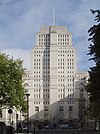Royal Postgraduate Medical School
This article relies largely or entirely on a single source. (July 2023) |
The Royal Postgraduate Medical School (RPMS) was an independent medical school, based primarily at Hammersmith Hospital in west London.[1] In 1988, the school merged with the Institute of Obstetrics & Gynaecology, and in 1997 became part of Imperial College School of Medicine.
History
The medical school had its roots in the British Postgraduate Medical School, based at Hammersmith Hospital. It incorporated by
The school became part of the British Postgraduate Medical Federation in 1947, and was known as the Postgraduate Medical School of London. In 1974 the school became independent, with a new charter and the title Royal Postgraduate Medical School. Its separate status ended in 1997 with its assimilation into Imperial College London. Hammersmith Hospital is now a district general hospital and is still a centre of postgraduate medical education and research, although its influence is much less than in the past.
Controversy
An article entitled 'Human Guinea Pigs: A Warning' published in 1962 in the journal Twentieth Century by
See also
References
- ISBN 978-1-4471-0773-6, retrieved 17 July 2023
- ISBN 978-94-011-6360-6.
Further reading
- Roelcke, V., Maio, G. (eds.), Twentieth Century Ethics of Human Subjects Research (Franz Steiner Verlag, Stuttgart, 2004), p. 181.
51°31′3″N 0°14′1″W / 51.51750°N 0.23361°W

